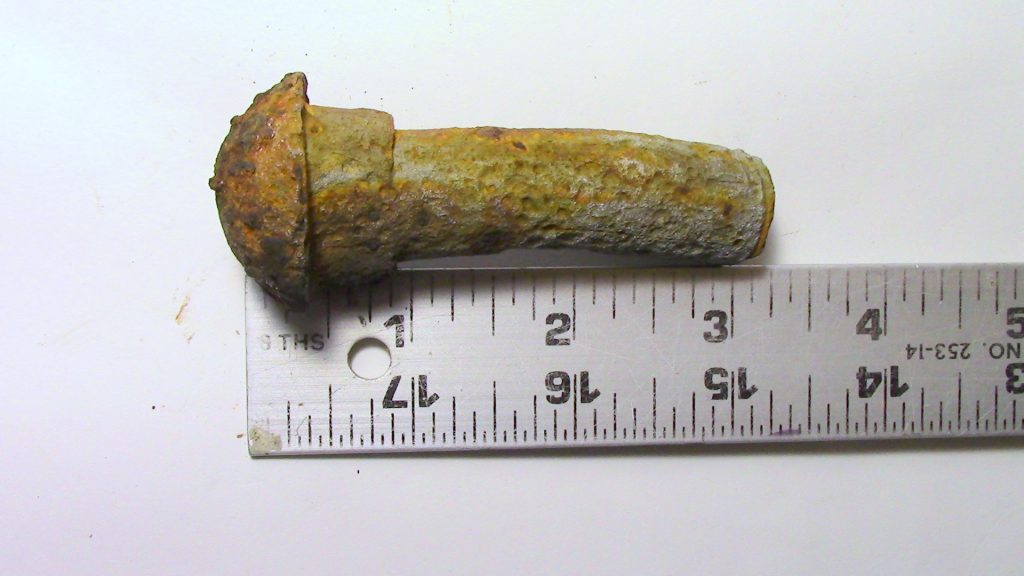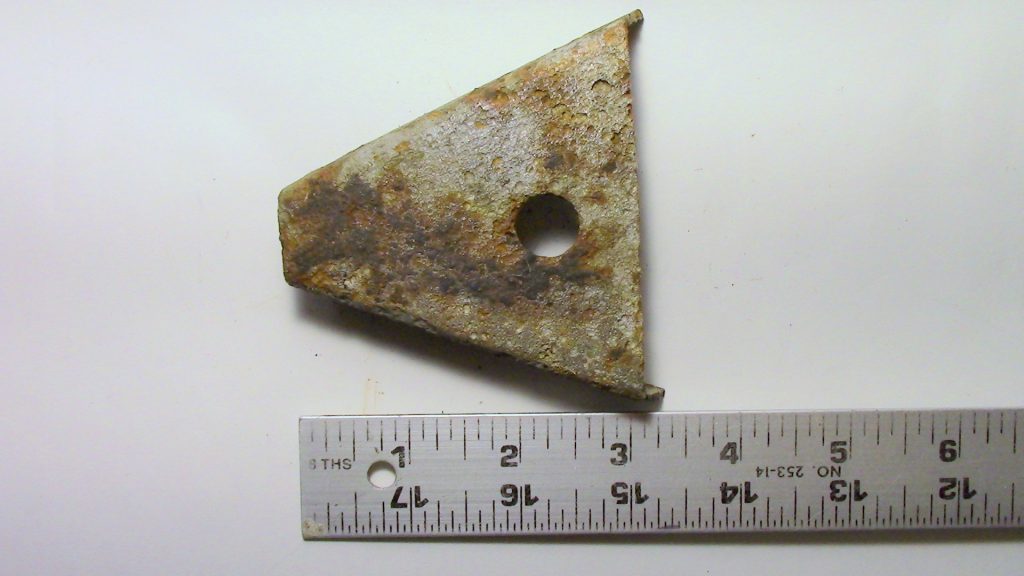Studying the Fishing Creek Bridge
On April 10, 2021, several members of the Hagerstown & Frederick Railway Historical Society gathered at Lewistown to document the remains of the Fishing Creek Bridge and recover artifacts with permission of the Lewistown Fire Company which owns the property.
During the study, the surviving bridge piers were measured and mapped and over a dozen artifacts were recovered from the site with the aid of metal detectors.
Site Description
The Fishing Creek Bridge actually consists of two bridges on a curve connected by a short raised berm. The north bridge crossed Fishing Creek itself and consisted of one tall and one short abutments with two trapezoidal piers equidistant between them. The south bridge covered a low area which served as overflow for the creek during floods and consisted of one large and one almost-ground-level abutment.
All but the pier closest to the creek survives today. The metal decking was removed when tracks were removed c.1958. The abutment closest to Hessong Bridge Road has suffered wear and one end has been destroyed, however the concrete of this abutment contains a USGS marker.
Survey Results
The diagram below shows the shape of the bridge, surviving parts and detailed measurements of the site. Also shown is a 3D render of the surviving bridge piers.


Lewistown “Station”

Across Hessong Bridge Road can be found a gravel parking area and former store. The gravel area was once the site of the H&F power substation and the structure which remains, while modified today, was a private business which served as the station. A waiting shelter likely stood on the property as well. To the left of this structure was the Lewistown passing siding as well as a freight siding, and behind the building additional freight sidings existed. A shed on the property bears evidence that it may have been constructed as a freight shed. The main Right-Of-Way alongside the main structure can be identified by spaced pairs of brass markers embedded in the ground reading “T. P. E. Co.”

The store structure remains privately owned and is a warehouse and workshop for a nearby business. While expanded and rebuilt, portions of the original exterior wall still remain inside of the structure as does part of the original grain blower and chute from the associated grain elevator operation. The owner of this building gave permission for recovery of artifacts from the property as well.


Items discovered on site
Several items were recovered from the properties. Some can be identified while some remain a mystery and may or may not be related to the railway.
Various Railroad Spikes
Spikes were recovered from both properties. Two spikes are on display in the museum. The larger, regular railroad spike displayed is of an unknown origin, however it was donated by Elizabeth Duke as part of the Carroll James Collection and could possibly be from another H&F location, including Thurmont or Frederick where heavier railroad equipment occasionally shared H&F tracks.





Rail joint bars
Also called Fishplates, these pieces were used to sandwich the ends of two pieces of rail being held together. Bolts were used to hold one plate on either side of the rail. Three of these plates were recovered: two on the ground surface and one excavated from the railroad berm.









Rail bolts
Two of these bolts were recovered, one on each property. The bolts were used to hold a pair of fishplates together. Also found near one of these bolts was a nut which was cut from a bolt and a heavily degraded washer which would fit against a bolt head.






Pitch Point Crowbar
This heavy-duty crowbar was used for shifting pieces. It may have been used to pry bridge decking from bolts or remove rails from spikes. In addition, rail jacks were also designed to use these tools as a handle. The crowbar was buried vertically in the side of the railway berm between the bridges and is bent near the middle point. For this reason, we believe that the tool was left behind after being damaged during the removal of the rails and was forgotten.
Of interesting note is the ownership stamp in this crowbar. The tool was originally owned by the Norfolk & Western Railway (N&W RY) which the H&F crossed in Hagerstown. It was likely purchased or borrowed from the N&W in that city and migrated in use across the H&F system before being left in Lewistown, aThis provides the first evidence of second-hand tools in the later years of the railway operations.





Suspected rake head.
Below you can see a triangular piece of metal excavated from the rail berm, we suspected that this may have been the point at which tines were attached to the handle of a work rake. More research is required.


Unidentified Pieces
Several pieces of metal were excavated on both properties. Small fragments may have been cut from the bridge decking or fallen from railcars over the years, other pieces may be parts of railroad equipment or cargo. Suggestions for the identity of these objects are welcome.










